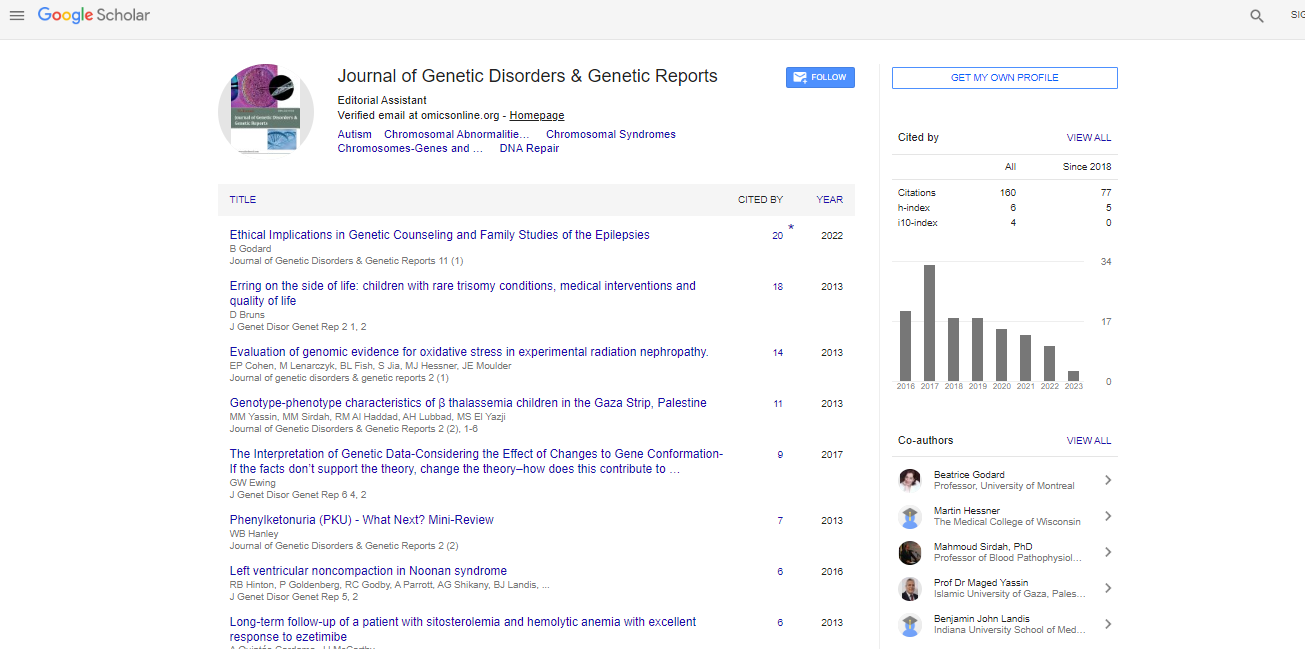Case Report, J Genet Disor Genet Rep Vol: 5 Issue: 2
A Case of Wolf-Hirschhorn Syndrome and Familial Mediterranean Fever
| Kazuaki Matsumoto1,2* and Masayasu Ohta1 | |
| 1Department of Pediatrics, JA Toride Medical Center, Ibaraki, Japan | |
| 2Department of Pediatrics and Developmental Biology, Tokyo Medical and Dental University, Tokyo, Japan | |
| Corresponding author : Kazuaki Matsumoto Department of Pediatrics and Developmental Biology, Tokyo Medical and Dental University, Tokyo, Japan Fax: 0297-74-2721 Tel: 0297-74-5551 E-mail: jumbleworks@gmail.com |
|
| Received: March 28, 2016 Accepted: April 20, 2016 Published: April 26, 2016 | |
| Citation: Matsumoto K, Ohta M (2016) A Case of Wolf-Hirschhorn Syndrome and Familial Mediterranean Fever. J Genet Disor Genet Rep 5:2. doi:10.4172/2327-5790.1000133 |
Abstract
Wolf-Hirschhorn syndrome is a genetic syndrome that includes growth failure, mental retardation, congenital heart disease, typical facial features and epilepsy. This syndrome is associated with a microdeletion of the short arm of chromosome 4. Familial Mediterranean fever is a hereditary autoinflammatory disorder characterized by fever and serosal inflammation that affects abdomen, chest and joints. This disorder is associated with mutations in MEFV located on chromosome 16p. We report a case of a child with Wolf-Hirschhorn syndrome presenting with recurrent fever, vomiting and diarrhea and diagnosed with familial Mediterranean fever. MEFV sequence showed complex allele mutations. Colchicine shortens the duration and ameliorates the severity of symptoms, which avoid hospitalization. We discuss the difficulty in diagnosing these two relatively rare comorbities and review literatures.
Keywords: Mediterranean fever, Wolf-Hirschhorn syndrome, Congenital heart disease, Autoinflammatory disorder
Keywords |
|
| Mediterranean fever; Wolf-Hirschhorn syndrome; Congenital heart disease; Autoinflammatory disorder | |
Introduction |
|
| Wolf-Hirschhorn syndrome (WHS) is a rare genetic syndrome caused typically by a hemizygous deletion of the short arm of chromosome 4 [del (4)(p16.3)]. The vast majority of the cases are caused by a microdeletion in the variety of genes (WHSCR1, WHSCR2, LETM1, MSX1 FGFR1 genes) and the length of deletion contributes to the specific clinical phenotype [1-4]. | |
| Major clinical features of WHS are hypospadias, congenital heart diseases, renal and ophthalmic defects, and skeletal abnormalities. Typically the patients develop intractable epilepsy and have growth and developmental retardation. Characteristic craniofacial features in patients with WHS are prominent glabella, high arched eyebrows, hypertelorism, scalp defects, cranial asymmetry, hypoplastic maxilla, broad nasal bridge and short philtrum. The distinct facial feature is described as a “Greek warrior helmet”. Urinary tract malformations (such as renal agenesis, oligomeganephronia, bladder exstrophy, cystic dysplasia and obstructive uropathy) are also observed [5]. The patients with WHS and comorbid immunodeficiency (IgA deficiency, IgG2 subclass deficiency, common variable immunodeficiency) were also reported [6]. However, the patient with WHS and comorbid familial Mediterranean fever (FMF) has never been reported. | |
| FMF is an autosomal recessive inherited disease and one of the periodic fever syndromes. Many of them are rare other than periodic fever with aphthous stomatitis, pharyngitis, and adenitis (PFAPA) and FMF. However, FMF is also rare in the Japanese population [7]. Clinical manifestations include recurrent and self-limiting fever that usually lasts 3 to 4 days accompanied by peritonitis, synovitis, pleuritis and rarely pericarditis. Clinical phenotypes are variable even in the members of the same family. The intervals of febrile episodes are irregular and no specific prodrome is identified [8]. | |
| Here we report the novel case of WHS and FMF and review literatures. | |
Case Report |
|
| We report a 10-year-old boy who was diagnosed with Wolf- Hirschhorn syndrome (WHS) soon after delivery and developed familial Mediterranean fever at the age of 9 years and 8 months. His parents are Japanese and have no genetic diseases and have not suffered from recurrent fever episodes. His family history was notable and the family tree was shown in Figure 1. The maternal grandmother of the proband suffers from recurrent fever lasting no more than 1 week accompanied by arthralgia and rash. Work up for collagen diseases, especially rheumatoid arthritis, was performed but diagnosis has not been made. The brother of the maternal grandmother is on hemodialysis due to renal failure of unknown cause and his daughter had a renal transplant. In the paternal side of the maternal grandmother, there were several persons with kidney diseases but no detailed information is available. The family tree is shown in Figure 1. | |
| Figure 1: The family tree was shown. The man pointed by an arrow is the proband. The man A had a renal disease but the detail is unclear. The woman B suffers from recurrent self- limiting febrile episodes and arthralgia but the diagnosis is not made. The man C is on hemodialysis. The woman D had a renal transplant. | |
| The pregnancy was not complicated. He was born via normal vaginal delivery at 39 weeks of gestational age with a weight of 2158g (-2.47SD). Apgar score was 4 and 7. The diagnoses of transient tachypnea of newborn and neonatal distress were made. Endotracheal intubation and mechanical ventilation were performed. Dopamine was used to treat transient hypotension. Neonatal jaundice was treated with phototherapy. After extubated, he developed apnea and a brain CT scan showed mild cerebral edema, for which aminophylline was prescribed. ABR threshold was 50dB in the left and 40dB in the right. No abnormality was found in other organs. Other clinical manifestations included prominence of the glabella, hypertelorism, high and arched eyebrows, short philtrum, broad nasal bridge, hypoplastic ears and ectopic Mongolian spots. G banding showed 46, XY, del (4) (p16), and therefore Wolf-Hirschhorn syndrome was diagnosed. He took nutrition orally and was discharged at the age of 39 days. After he was discharged, growth and psychomotor retardation was prominent. He cannot sit alone now. | |
| At the age of 8 months, he developed intractable epilepsy and he was started on tube feeding due to dysphagia. Various antiepileptic drugs were tried but he was frequently hospitalized due to status epileptics until he was 4 years old. Now he is treated with phenobarbital, topiramate, potassium bromide and clobazam, and epilepsy is well-controlled. The latest EEG recorded at the age of 8 years showed profound epileptiform spikes dominantly in the bilateral occipital leads. | |
| At the age of 2 years, he developed spiky fever and blood tests showed high inflammatory response. Blood culture was positive for Streptococcus pneumoniae and he was treated with an intravenous antibiotic. | |
| At the age of 3 years, he developed glycosuria, proteinuria, panaminoaciduria and profound elevation of β2-microglobuline in urine, and diagnosed with Fanconi syndrome. At that time, he was just started on valproate. Valproate-induced Fanconi syndrome was suspected. Valproate was discontinued and levocarnitine was started. Subsequently Fanconi syndrome subsided. | |
| From the age of 5 years, he suffered from recurrent fever that usually lasted 3 to 4 days and was accompanied by vomiting or diarrhea. The elevation of C-reactive protein (CRP) was usually observed on febrile episodes. He was diagnosed with urinary tract infections or acute gastroenteritis on several occasions but the focus of most of the recurrent fever was unclear. He often needed intravenous fluid administration and hospitalization due to transient intolerance to tubal feeding. His mother sometimes said he looked to have arthralgia but it was not obvious because he couldn’t speak any words. An abdominal CT scan and voiding cystourethrogram (VCUG) performed at the age of 9 years showed no anatomical abnormality in the urinary tract or vesicoureteral reflux. | |
| At regular visits, he takes routine blood tests and urinalysis for therapeutic drug monitoring of anti-epileptic drugs. The data taken when he developed self-limiting fever accompanied by diarrhea and when he was afebrile at the age of 9 years were shown in Table 1. When he developed fever, blood tests showed high CRP levels. Serum amyloid A level was also high. Of note, serum IgG levels and urinary beta2-microglobulin (B2MG) levels were markedly high irrespective of fever. Urinary N-acetyl-beta-D glucosaminidase (NAG) was not elevated (data were not shown). As described above, his strong family history of renal failure and recurrent fever was obtained at this time and familial Mediterranean fever was suspected. Genetic test demonstrated three missence mutations in MEFV, E148Q; P369S; R408Q. His vomiting and diarrhea accompanying fever were thought as manifestations of serosal inflammation. He was started on colchicine, which did not lead to complete remission but could ameliorate the symptoms and avoid hospitalization. His cystatin C level is slightly elevated, which suggests renal amyloidosis. We hope colchicine could slow the progression of renal amyloidosis. Renal biopsy is not planned because the parents’ consent cannot be obtained. | |
| Table 1: Laboratory data obtained when the patient was febrile and afebrile were shown with reference ranges of adults. | |
Discussion |
|
| The patients with WHS are susceptible to bacterial infections such as pneumonia and urinary tract infection. Therefore recurrent febrile episodes themselves could hardly remind us of periodic fever syndromes as one of differential diagnosis. On the febrile episodes, he often presented with vomiting and diarrhea without respiratory symptoms. A CT scan and VCUG demonstrated no abnormalities and the SAA elevation in the febrile episode was observed. SAA elevation is often observed in bacterial, viral infections and other inflammatory diseases even if CRP elevation is not observed. In our case a viral and bacterial infection was denied, which lead us to suspect autoinflammatory diseases. Patients with WHS are generally susceptible to bacterial infections due to variety of causes, such as immunological or anatomical. Therefore we tend to make a diagnosis of infections when they present with fever. | |
| A previous study showed urinary B2MG and NAG increased in FMF patients during febrile attacks and decreased in the postattack periods, and persistent elevation of both urinary B2MG and NAG was observed in the renal amyloidosis patients [9]. Our case has marked elevation of urinary B2MG, but not NAG. The cause of this phenomenon is unclear but normal urinary NAG implies his renal tubules might not be damaged by renal amyloidosis. Another study showed serum B2MG decreased during FMF attacks [10] but the serum B2MG elevation was observed in our case. The mechanism is not clear but we should not rule out FMF when B2MG elevation is observed during attacks. | |
| Genotype-phenotype correlation of FMF was investigated in Japan [11]. On the basis of Tel Hashomer criteria, patients were categorized into typical or atypical form of FMF depending on clinical manifestations. Exon 10 mutations predicted the typical phenotype and exon 3 mutations predicted the atypical phenotype. The study also demonstrated Japanese patients had a higher prevalence of the high-penetrance mutation M694I, and low-penetrance mutations E84K, L110P, E148Q, R202Q, G304R, P369S, R408Q in MEFV. The number of MEFV mutations had no influence on clinical phenotype. Other study showed E148Q is found frequently in east Asia [12]. Our case has complex allele mutations, E148Q (exon2); P369S (exon3); R408Q (exon3) in MEFV gene. Tel Hashomer criteria were met, but the clinical manifestations could not easily thought as symptoms of FMF and could be categorized into the atypical form, and the characteristics were compatible with genotype-phenotype correlations depending on the previous study. The fact that he cannot speak any words contributed to the delay of diagnosis. | |
| We should consider autoinflammatory disorders in the differential diagnosis of recurrent fever even if the patients have a congenital disease susceptible to bacterial infections. | |
References |
|
|
|
www.scitechnol.com/peer-review/ring-9-chromosome-syndrome-in-black-african-infant-d3gL.php
 Spanish
Spanish  Chinese
Chinese  Russian
Russian  German
German  French
French  Japanese
Japanese  Portuguese
Portuguese  Hindi
Hindi 



